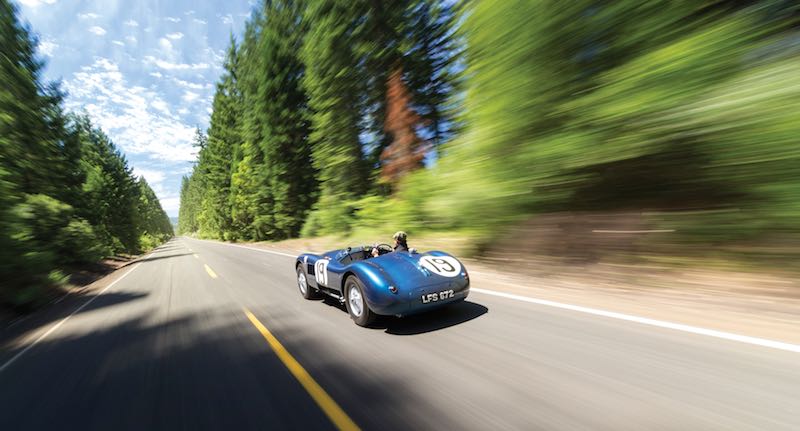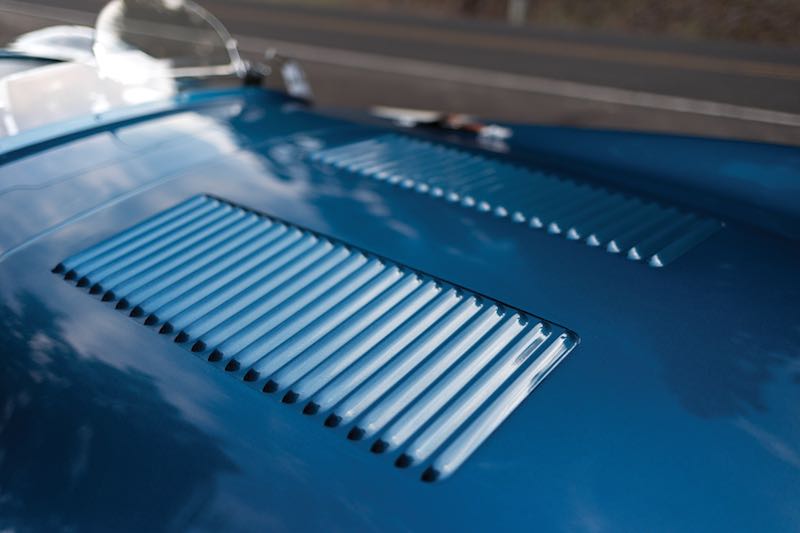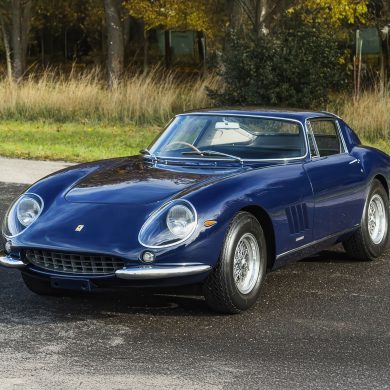Few sports-racing cars have achieved such legendary status as the Jaguar C-Type, which won the 24 Hours of Le Mans twice for Coventry during the company’s domination of the event in the 1950s. The C-Type began life as the famed XK120 roadster, which had taken the world by storm in 1948 with its revolutionary dual overhead-cam engine.
Several privateering customers entered factory-supported XK120 examples at the 1950 Le Mans race, and Leslie Johnson’s car was remarkably competitive, spending considerable time in 4th place. After watching the event, Jaguar founder Sir William Lyons and engineer Bill Heynes were convinced that a lighter, more aerodynamic body with modified XK120 mechanics had a strong chance of winning the race.
Development work soon commenced, starting with a new lightweight tubular space frame, one of the very first uses of the technique in sports car construction. The XK120’s rear suspension was redesigned with additional positioning links, and the 3.4-liter XK engine received a new cylinder head, high-lift camshafts, racing pistons, and an un-muffled dual exhaust system, raising the motor’s output to 200 horsepower. Most noticeable, however, was the new car’s exquisite coachwork, a fluid aerodynamic conjunction of curves and bulges penned by Jaguar stylist Malcolm Sayer. The first three cars were hand built in only six weeks and were the first purpose built race cars for Jaguar. That purpose was to win Le Mans, which they did twice.
Initially known as the XK120C (C for competition), the C-Type debuted at Le Mans in 1951 with a team of factory-sponsored cars. While two of the three entries were forced to retire early with oil line issues, the car driven by Peter Walker and Peter Whitehead took the overall victory, the first British car to win Le Mans in nearly 20 years.
Jaguar not only won Le Mans, but they did so handily, finishing 77 miles ahead of the 2nd-place finisher and setting the following records: fastest lap speed of 105.232 mph, 24 hour speed record of 93.495 mph, and they travelled the greatest distance in 24 hours, 2,243.886 miles.
The triumph spurred considerable customer interest, of course, and the new racing model was put into limited production, with 50 cars built by early 1953. The factory’s 1952 Le Mans campaign was less successful, with all three Works cars retiring early due to cooling system issues. Considering the domination of Mercedes-Benz’ 300 SL, Coventry’s engineers realized that the C-Type required a few upgrades to remain competitive for 1953, and a final run of three cars began development.
XKC 052 – On the Track
Chassis XKC 052 is the second of those three lightweight Works examples that were prepared specifically for the 1953 running of Le Mans. These cars constituted the final examples of the mighty C-Type (a last development car wore a D-Type-style body), and featured a number of upgrades over the prior examples. Improvements included new thin-gauge aluminum coachwork, more powerful Weber carburetors, a fully synchronized gearbox and triple-plate clutch, an additional upper link to the rear axle, and a rubber aircraft fuel bladder amongst other lighter weight-saving components. Most importantly, the three cars were the only lightweight C-Types built by the factory, and were the first disc-brake equipped entrants to ever run Le Mans, the only cars so outfitted among the 1953 field. This distinction proved to be quite significant in the race’s outcome.
On February 12, 1953, chassis no. XKC 052 was tested by Norman Dewis in preparation for the upcoming race. Wearing #19, the C-Type was entered with its two sister cars (XKC 051 and XKC 053) during Le Mans weekend of June 13, 1953, piloted by Peter Whitehead and Ian Stewart. As the sun set on the first day of competition, Jaguar, Ferrari, and Alfa Romeo appeared to be the teams to beat. But with the rigors of endurance racing taking their toll, only one of the three Ferraris managed to stay in the race by the next morning, while all three Alfas retired early.
The three C-Types, essentially unmatchable through the curves with their low weight and disc brakes, continued to set the race-leading pace, with 051 and 053 in 1st and 2nd place respectively, and 052 only a few laps behind in 4th. This order remained through the race’s conclusion, with Briggs Cunningham’s C5-R preserving third place to stave off a 1-2-3 sweep by the Coventry team. With Ian Stewart concluding driving duties at the end of the 24 hours, XKC 052 completed 297 laps compared to the winning Jag’s 304 laps, with an average speed of almost 167 km/h.
Jaguar C-Type Works Lightweight – Profile Page Two
Following this smashing success, XKC 052 continued its factory competition campaign, with appearances at Silverstone and Goodwood, but mechanical issues resulted in two DNFs. By the end of the 1953 season, Coventry was beginning development of its next sports-racing model (soon to be known as the D-Type) for the following year’s Le Mans, as the company was far more interested in competing at Sarthe than other venues or series. Consequently, in November 1953, chassis no. 052 was prepared for private sale, with a rebuild to Le Mans specifications, and sold to the well-known Ecurie Ecosse.
On December 12, 1953, the Scotland-based scuderia registered the Jaguar with tags reading “LFS 672.” Painted the Ecurie’s signature color of Flag Metallic Blue, XKC 052 was mostly driven by Jimmy Stewart, older brother of famed Jackie, through May 1954, finishing 1st three times at Goodwood, and once at National Ibsley. In early June, future Le Mans winner Roy Salvadori took over for Stewart, winning two events at Snetterton on June 5 before Stewart returned to finish first at Goodwood two days later. Ninian Sanderson then became the car’s principal driver for the next month, taking 2nd place at National Oulton Park on June 12 and at the National Charterhall race on July 11. Salvadori claimed another checkered flag at National Charterhall on September 4, following it up with a 2nd-place finish at the Penya-Rhin Grand Prix on October 10. In total, XKC 052 netted Ecurie Ecosse eight victories during 1954, with four 2nd-place finishes, four 3rd-place finishes, and three 4th-place finishes, a remarkable overall record for a single season.
In the October 22, 1954 issue of Autosport magazine, the Ecurie Ecosse advertised all three of its 1954 team cars for sale, and XKC 052 was soon thereafter purchased by the well-known Peter Blond. Repainting the C-Type green, Mr. Blond used the car for club racing through 1956, finishing second at Goodwood in March 1955, and 5th at the Spa Grand Prix in May with Hans Davids at the wheel. Three 4th-place finishes at the Goodwood International, BARC Goodwood, and the Crystal Palace International rounded out the 1955 season. The following March, Mr. Blond improved upon his BARC performance with a 3rd place finish at the Goodwood event.
By mid-April 1956, XKC 052 passed to Maurice Charles, who continued the car’s racing endeavors with appearances at Goodwood and the Aintree 100, and a 5th place finish at Brands Hatch on August 6. Mr. Charles offered the car for sale in October, and it was soon after purchased by Jim Robinson of Northhampton, who ran the car twice at the Evesham sprints, finishing as high as 2nd in class. The owner advertised the car twice in Autosport during 1957, eventually selling the C-Type to Alan Ensoll later that year.
Mr. Ensall somewhat renewed the car’s competition relevance with some stronger driving in various hillclimbs and sprints, taking 3rd place at Charterhall in May 1958, and 1st in class at Barbon Hill and Yorkshire. Second-place finishes were achieved at Charterhall and Catterick Camp, with an all-out victory earned at the Castlewick Hillclimb in June.
In September 1958, Mr. Ensall sold the Jaguar to Tom Candlish, and the car remained competitive with a 4th-place result at Charterhall, and 1st-overall finishes at the Rest-and-Be-Thankful hill climb championship and the unlimited GT race at Charterhall in July 1959. During an outing around this time, XKC 052 was involved in a moderate accident, and in late 1959 the important racecar was sold to Ian Denney, who completely restored it, including a new lightweight body. Passing in 1969 to Brian Classic, the car was acquired in 1970 by Paul Grist, who cosmetically returned the car to its former Ecurie Ecosse livery.
XKC 052 – On the Road
In 1971, the C-Type found a more permanent home when it was purchased by the esteemed Martin Morris, one of Britain’s better-known collectors of the period. The car remained in the Morris family’s purview for over 30 years, finally reaching the status of rare collectable. In one of the C-Type’s final period outings, Stephen Curtis ran it at the Le Mans 50th Anniversary event on June 9, 1973, finishing a commendable 11th place.
In 1986, Mr. Morris commissioned a comprehensive two-year restoration of XKC 052 that was publicly enjoyed a few years later with the car’s participation in the Jaguar factory Cavalcades to Le Mans in 1991 and 1993. In 2000, Morris’s son assumed control of the C-Type’s care, and he soon sold the car into American ownership for the first time in its existence. XKC 052 was purchased then by the consignor, one of the world’s foremost collectors of important vintage sports cars, and a regular exhibitor at premium concours d’elegance, including Pebble Beach.
The consignor’s first order of business was a proper renewal to 1953 Le Mans specifications, which he entrusted to John Pearson of the United Kingdom. The C-Type was completely mechanically refreshed, and mounted with new, completely accurate lightweight thin-gauge aluminum coachwork built by RS Panels to the factory-correct thickness. The body was finished in the Ecurie Ecosse livery, with a fresh coat of famous blue paint, and decorated with #19 roundels. The 1959 replacement body has been retained, for the car’s overall historical record and completeness.
Following the completion of Mr. Pearson’s exacting work, the consignor began to enjoy the Jaguar on various rallies and tours, starting with the factory C-Type Cavalcade to Le Mans in June 2001. XKC 052 was also featured on the cover of the December 2001 issue of Classic Jaguar World magazine. In August 2002 the car was exhibited at the Pebble Beach Concours d’Elegance as a display-only, non-judged entry, while in April 2005, it participated in the California Mille. Four months later, the C-Type drove the prestigious Quail Rally staged in conjunction with the Quail Motorsports Gathering in Carmel Valley, California.
Enjoying climate-controlled storage and regular maintenance and attention as needed ever since, XKC 052 has benefited from a pampered life over the last 15 years, and still displays the beautiful quality of Mr. Pearson’s restoration.
Now publicly available for the first time in many years, this historically significant C-Type is one of those rare sports-racing cars that truly embodies a crowning acquisition. It is a very significant component of Jaguar’s storied racing history, and remains one of the rarest and significant race cars of that period, let alone one of the most timelessly beautiful sports cars ever designed. Also the apogee of the C-Type’s technical development, this highly desirable Factory Lightweight would make a spectacular addition to the most pedigreed collections, enjoyable for its brisk performance in vintage rallies and heats. XKC 052 also promises acclaim at the world’s finest concours, offering future ownership a singular landmark in the Coventry legend.
—
This Jaguar C-Type Works Lightweight that finished 4th overall at Le Mans in 1953 will be offered at the RM Sotheby’s Monterey sale, scheduled for August 13-15, 2015 in Monterey, California.
Jaguar C-Type Works Lightweight XKC 052 – Photo Gallery




































GORGEOUS!!